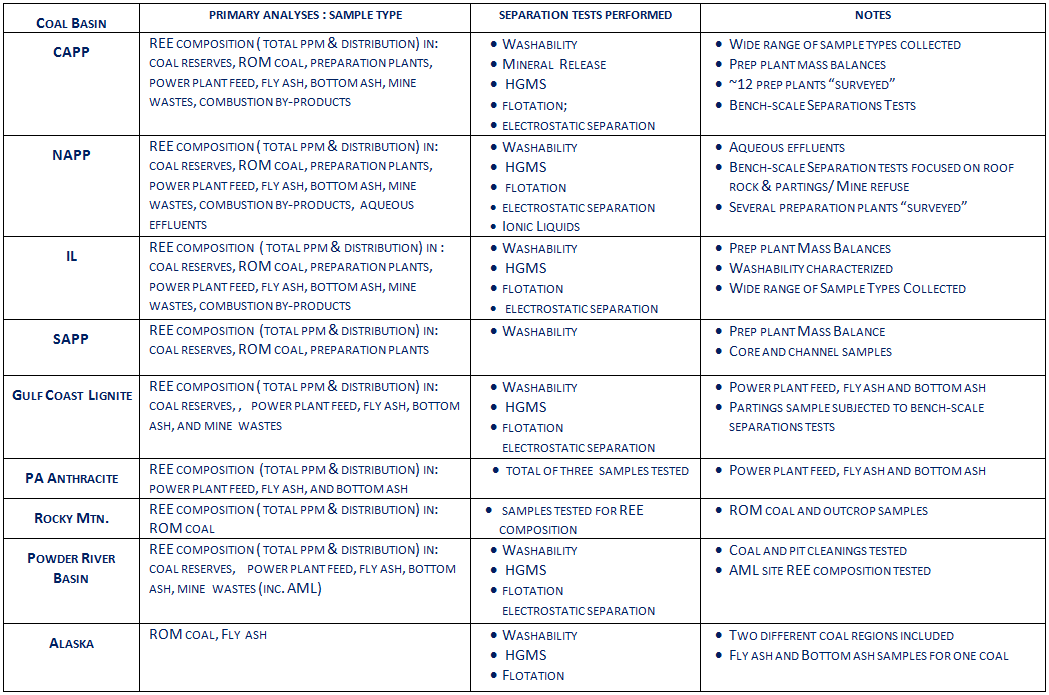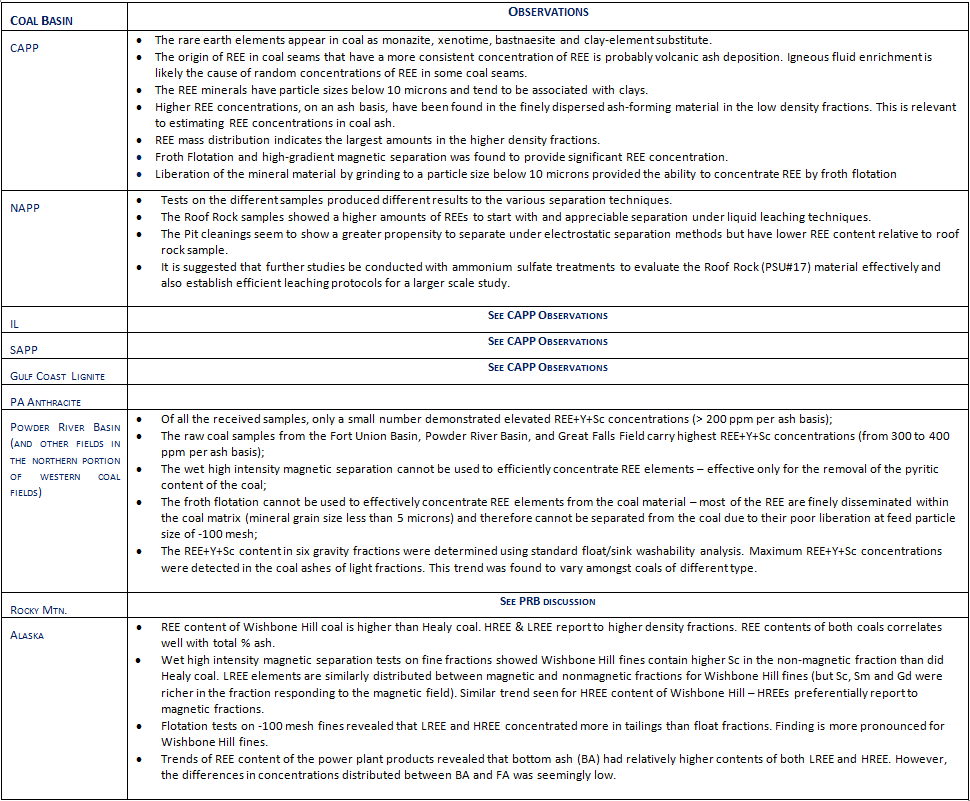NETL Field Analysis
Introduction
In FY14, DOE/FE/NETL conducted a preliminary, short-term, baseline field evaluation of coal and coal by-products as potential domestic resources of REEs. The study involved the sampling, analysis, characterization, and testing of a substantial number of coal-based samples. The resulting data are meant to be widely available to government policy and program analysts, industry and academic stakeholders, and possible program participants. The data has been used to support the Department’s Report to Congress that summarizes the opportunities and challenges of recovering REE elements from coal and coal by-products, an analysis of the technological pathways that exist or might be developed for obtaining REEs from coal, and the outlines of a proposed R&D program.
Opportunities for REE recovery along the Coal Value Chain as the basis for the structure of the field evaluation
Figure 1 (below) presents a summary view of the coal value chain and provides a list of the main opportunities that might be exploited in recovering REEs from coal, coal by-products and mine refuse. The chart showing how the sampling and characterization study was designed and structured to examine the potential for REE recovery at various points along the coal production, processing, and utilization lifecycle. A more thorough description of the rationale for this structure is presented on the subsequent pages.
1. Resource Production: This category includes samples gathered during field work and from state geological surveys associated with development of the Report to Congress and historical samples collected by USGS that have been used in resource estimation. The data associated with each of these samples includes: a description of the source; a sample ID number assigned by those performing this study that can be used to track this sample– These samples were analyzed for %ash, moisture, and the concentration of fourteen rare earth elements (La, Ce, Pr, Nd, Sm, Eu, Gd, Tb, Dy, Ho, Er, Tm, Yb, and Lu) plus two elements generally included in this grouping (Y and Sc). In addition to the measured REE’s, a number of other elements were also measured during these analyses. Four elements were routinely included for all samples (U, Th, Ir, and Co). A larger set was requested by partner organizations that supplied samples or allowed samples to be taken at their facilities (some of these sample gathering exercises were conducted under NDAs (Non Disclosure Agreements) which limited the elements that could be measured and reported). This list includes 11 elements (Pt, Os, Re, Te, Ag, Pd, Rh, Ru, Se, Ga, and Ge) requested as a result of discussions with the West Virginia Geological and Economic Survey, and four (Al, Ca, Ni, and V) requested by various partner organizations.
The data file found under this category heading is an Excel spreadsheet that includes all samples gathered directly in the form that is reported (i.e., core samples, ROM coal, feed coal to a preparation plant or combustion system, fly ash, bottom ash, refuse coal at a surface mine site, partings or pit cleanings, etc.). Other results that were generated by further processing in laboratories in order to perform additional characterization tests (washability analysis, bench-scale separation tests, etc.) are reported in other data files under the categories that apply.
a. Resource Production/Coal Reserves: This subcategory consists solely of samples that were taken in a manner consistent with normal practices for core samples (i.e., large partings, 4” in height, were removed before the elemental analysis was performed). These samples can be found within the “Collected samples spreadsheet” by the following search of that Excel spreadsheet: Type Sub-category > GEO filter.
b. Resource Production/Coal Mining: This subcategory consists of two sub-subcategories:
i. Resource Production/Coal Mining/Pit Cleanings: The first focuses on samples taken at coal mines, particularly at surface mines, that can be described as pit cleanings. The pit cleanings are often refuse coal (material containing a high amount of mineral matter but also a significant amount of coal that is not included for sale as a specification coal). Some of these materials may be used in circulating fluidized bed units that can handle high ash coals; some of this material is simply managed at the site. Channel sample data, when available in the “Collected samples spreadsheet” can yield useful insight into the REE content of the off-specification material. These samples can be found within the “Collected samples spreadsheet” by the following search of that Excel spreadsheet: Type Sub-category > COL filter.
ii. Resource Production/Coal Mining/ Co-mining: This sub-subcategory includes whatever data we have on analysis of roof and floor materials. The roof and floor material might contain appreciable amounts of REEs and be amenable to alternative processing to extract REEs.
2. Processing: This category includes data developed by performing standard coal washability tests and a range of bench-scale separations tests. The materials subjected to these tests came from a cross-section of the coal basins in the United States. These tests were conducted by the various participating organizations and are summarized in Table 1. Observations focused on the coals and by-products tested by each participant are summarized in Table 2 .
These tests were intended to both evaluate REE partitioning/concentration that might occur from current coal production, processing, and utilization and to suggest pathways forward for R&D into recovery of REEs from the same opportunities depicted in Table 1: Description of Analyses Performed during Field Evaluation (by coal basin) is a concise depiction of the sampling, analysis, characterization, and testing program that was conducted. It is organized according to the U.S. coal basin that the samples originated from. Not all samples were subjected to the same analyses and tests, as the table and its notes explain.
Overall scope of the field evaluation – Samples were gathered during a field sampling program from many US coal basins and from a cross-section of operating mines, preparation plants, power production facilities, and by-product holding sites. Figure 2: Geographic Location of REE Samples is a map of the U.S. showing the geographic coverage of these samples.
General observations from the data
A high-level summary of findings and observations, Table 2: Observations Based on Test Results (by coal basin), ties together the various components described above, and provides some insight into the types of information that could be gleaned from this preliminary field evaluation. These observations could serve as a basis for developing a more comprehensive R&D program.
3) Utilization: This category includes samples gathered during field work and from state geological surveys associated with development of the Report to Congress. The data associated with each of these samples includes: a description of the source; a sample ID number assigned by those performing this study that can be used to track this sample– These samples were analyzed for %ash, moisture, and the concentration of fourteen rare earth elements (La, Ce, Pr, Nd, Sm, Eu, Gd, Tb, Dy, Ho, Er, Tm, Yb, and Lu) plus two elements generally included in this grouping (Y and Sc). In addition to the measured REE’s, a number of other elements were also measured during these analyses. Four elements were routinely included for all samples (U, Th, Ir, and Co). In some cases, the aluminum and calcium contents were also measured .
The data file found under this category heading is an Excel spreadsheet that includes all samples gathered directly in the form that is reported (i.e., core samples, ROM coal, feed coal to a preparation plant or combustion system, fly ash, bottom ash, refuse coal at a surface mine site, partings or pit cleanings, etc.). Other results that were generated by further processing in laboratories in order to perform additional characterization tests (washability analysis, bench-scale separation tests, etc.) are reported in other data files under the categories that apply. These samples can be found within the “Collected samples spreadsheet” by the following search of that Excel spreadsheet: Type Sub-category > COM filter.








